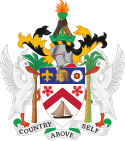| ||||||||||||||||||||||
| Outcome | Failed as two-third quorum in favour not met | |||||||||||||||||||||
|---|---|---|---|---|---|---|---|---|---|---|---|---|---|---|---|---|---|---|---|---|---|---|
| Results | ||||||||||||||||||||||
| ||||||||||||||||||||||
 |
|---|
| Administrative divisions (parishes) |
An independence referendum was held in Nevis on 10 August 1998. Although it was approved by 62% of voters, a two-thirds majority was necessary for the referendum to succeed. If it had passed, Nevis would have seceded from the Federation of Saint Kitts and Nevis. [1] [2]